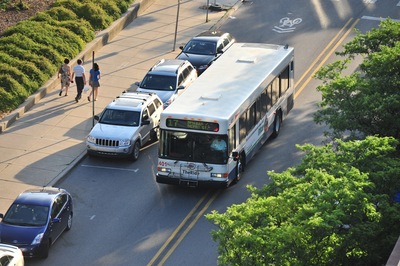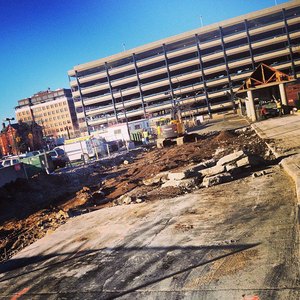Now that a countywide expansion of the Ann Arbor Transportation Authority has been halted, work has begun on a new strategy for expanding transit services in the county's urban core.
In a new written report to the AATA's governing board, AATA CEO Michael Ford said he has followed the Ann Arbor City Council's directive and engaged in discussions about an expanded transit network with leaders from Washtenaw County's urban core communities.
Ford said the urban core footprint includes the cities of Ann Arbor, Ypsilanti and Saline, and the townships of Ann Arbor, Pittsfield and Ypsilanti.

The AATA is looking to expand transit services in the county's urban core, but funding and governance issues still need to be worked out.
Ryan J. Stanton | AnnArbor.com
"The plan will address service, governance and funding and our target for completion is April 2013," he said. "We are currently focused on the development of a service cost and evaluation model."
Ford said a review process has been designed to ensure the AATA board and local elected officials are kept closely informed at each step along the way. Any needed clarifications and refinements will be made before passing the plan on to the city of Ann Arbor for review, he said.
Ford mentioned in his report to the board he also met with representatives from the village of Dexter and the Western-Washtenaw Area Value Express to discuss transit needs. Although they're not included in the urban core footprint, the AATA wants to keep the lines of communication open with neighboring communities and service providers as a new program is developed.
AATA officials haven't yet released specifics for how the expanded urban core transit services would be funded, but one option is that jurisdictions where new services are added could pay for the services through purchase-of-service agreements with the AATA. It's still unclear whether specific communities might levy special millages to come up with the additional funding.
Ypsilanti Mayor Paul Schreiber said another idea being considered is the formation of a new transit authority for eastern Washtenaw County — including Ypsilanti, and Pittsfield and Ypsilanti townships — and having that authority levy a millage and partner with the AATA to provide services.
"I don't know how it's going to shake out," he said. "There are a number of different options. This all has to do with revenue. In the city of Ypsilanti, our current charter millage does not cover the payment even for the current service we're getting, let alone an increase in service."
Eastern Washtenaw communities already pay for services from the AATA through purchase-of-service agreements, which some view as a less stable model since it leaves the continuation of services subject to the whims of future elected officials in each community.
"We need to have something that is a permanent source of funding for transportation so that one act from one unit of government can't mess up the whole transportation system," Schreiber said.
If the solution happens to be establishing a new transit authority, Schreiber said he'd gladly welcome any other communities beyond eastern Washtenaw that want to join.
"One of the challenges is figuring out what that millage amount would be," he said. "I would expect it would be less than half a mill."
Schreiber noted Ypsilanti already is at the state constitutional limit for millages for general operations, so it can't increase its transit levy. He said he's not counting on the formation of a Southeast Michigan Regional Transit Authority to be the solution for his community.
"I think we need to get something done this year, and we have to just assume that the RTA is not going to help us out right now," he said.

The footprint of a new Blake Transit Center in downtown Ann Arbor takes shape along Fifth Avenue on Thursday.
Ryan J. Stanton | AnnArbor.com
The board is expected to vote on a 2013-2017 capital and categorical grant program that includes $43.5 million in spending over five years.
That includes $10.4 million in spending this year, $7.3 million of which is federal formula funding, $1.4 million of which is other federal funding and $1.7 million of which is state funding.
The single-biggest expense item shown the plan comes in 2015 when $12.35 million is scheduled for replacement of large AATA buses.
The plan also shows $625,000 this year for the purchase of vans for the AATA's expanding vanpool program, plus another $550,000 each year from 2014 to 2017 for more vans.
The report also shows $1.3 million for replacement of large buses this year, plus $1.3 million for expanded bus services this year.
Ryan J. Stanton covers government and politics for AnnArbor.com. Reach him at ryanstanton@annarbor.com or 734-623-2529. You also can follow him on Twitter or subscribe to AnnArbor.com's email newsletters.